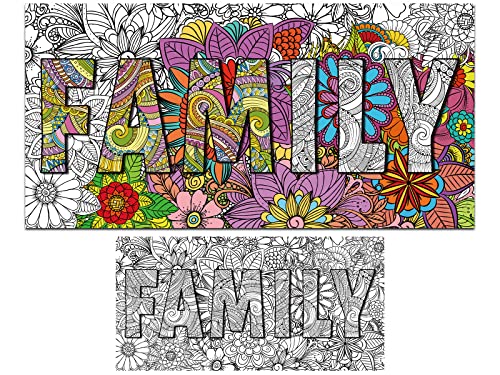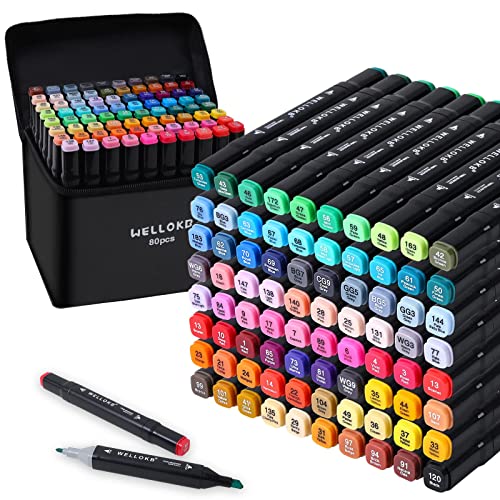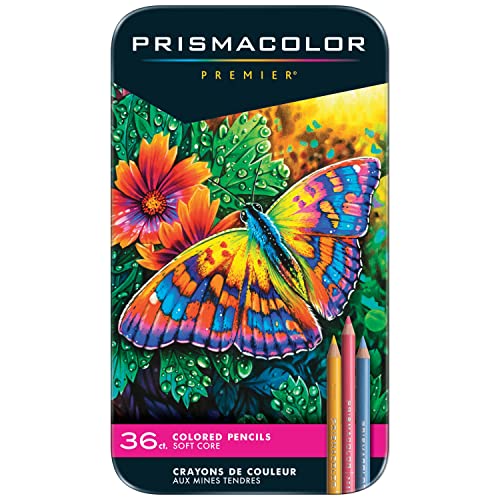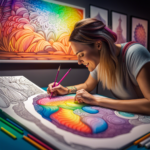Welcome to the step-by-step guide on how to enhance the therapeutic benefits of rejuvenating art therapy! This guide is designed to help you make the most out of your coloring experience and maximize the positive effects it can have on your well-being.

In this guide, we will explore the world of rejuvenating coloring for adults, which has gained popularity in recent years as a relaxing and therapeutic activity. Coloring has been proven to reduce stress, improve focus, and promote mindfulness. By following these simple steps, you will learn how to take your coloring sessions to the next level and fully immerse yourself in the therapeutic benefits it offers.
So, grab your coloring supplies and get ready to embark on a journey of relaxation, creativity, and self-care. Let’s enhance the therapeutic benefits of rejuvenating coloring together!
Rediscover your inner creativity with Art Therapy
1. Choose the right coloring materials
Select high-quality coloring materials such as colored pencils, markers, or pastels that provide a smooth and vibrant coloring experience. When choosing colored pencils, opt for those that are labeled as artist-grade or professional-grade, as they tend to have a higher pigment concentration and are less prone to breakage. Look for markers that are alcohol-based, as they offer a more intense and blendable color. Pastels, on the other hand, come in both oil-based and soft varieties. Soft pastels are ideal for blending and layering, while oil-based pastels provide a more opaque and vibrant result.
Consider the type of paper or coloring book that works best with your chosen medium. For colored pencils, a heavier weight paper such as cardstock or drawing paper is recommended, as it can withstand multiple layers and prevent color bleed-through. Markers generally work well on smooth, non-absorbent paper, such as marker paper or Bristol board, which allows the ink to flow smoothly without feathering. If you prefer using pastels, textured paper or pastel paper with a toothy surface is the best choice, as it helps to hold the pastel particles and allows for better blending.
By selecting high-quality coloring materials and considering the appropriate paper or coloring book, you can ensure a more enjoyable and satisfying coloring experience. Experiment with different combinations to find the ones that work best for you and unleash your creativity!
2. Create a calming environment
To create a calming environment for coloring, start by finding a quiet and comfortable space where you can fully focus on your coloring activity. This could be a corner in your bedroom, a cozy nook in your living room, or even a dedicated art studio if you have one. Make sure that this space is free from distractions, so you can immerse yourself in the therapeutic benefits of coloring.
Next, set the mood by dimming the lights or using soft lighting. This helps create a soothing atmosphere that can further enhance your relaxation. You can achieve this by using a dimmer switch, table lamps with low-wattage bulbs, or even string lights to add a gentle glow to your space. Experiment with different lighting options until you find what works best for you.
In addition to lighting, consider incorporating soothing sounds into your environment. Play relaxing music, such as instrumental melodies or nature sounds, to create a serene ambiance. If you prefer silence, you can also opt for noise-cancelling headphones to block out any external disturbances.
To amplify the calming effects, you may want to use essential oils. Select oils known for their relaxation properties, like lavender or chamomile, and use them in a diffuser or oil burner. Just a few drops can fill the room with a gentle fragrance, promoting a sense of tranquility as you color.
By finding a quiet and comfortable space, dimming the lights, playing relaxing music, and using essential oils, you can create a nurturing environment that enhances the therapeutic benefits of coloring. Take the time to set up your ideal space and enjoy the soothing experience of coloring in a calm atmosphere.
3. Practice mindfulness
Before you start coloring, take a few moments to center yourself. Find a quiet and comfortable space where you can relax. Sit or lie down in a position that feels comfortable for you. Close your eyes and take a deep breath in through your nose, allowing your abdomen to expand. Then, slowly exhale through your mouth, releasing any tension or stress. Repeat this deep breathing exercise a few times, focusing solely on your breath.
As you continue to breathe deeply, allow your mind to let go of any thoughts or worries that may be lingering. Imagine them floating away like clouds in the sky. Shift your focus to the present moment and the task at hand – coloring.
Approach coloring with a mindful and present mindset. As you select your coloring tools, pay attention to the weight, texture, and feel of each item in your hands. Notice the colors and patterns on the pages of your coloring book. Choose a design that resonates with you and sparks joy.
Once you start coloring, be fully present in the experience. Pay attention to the movement of your hand as it glides across the page. Notice the sensations of the colors as they meet the paper. Observe the shapes and lines taking form under your touch. Allow yourself to be immersed in the process, without judgment or expectations.
If your mind starts to wander, gently bring your focus back to the present moment. Use the act of coloring as an anchor to ground yourself. Let go of any thoughts about the past or future and simply enjoy the act of coloring. Embrace the calmness and relaxation that comes with this practice.
Remember, the purpose of practicing mindfulness while coloring is not to create a perfect masterpiece, but to nourish your mind and soul. Find joy in the simplicity of coloring and let it be a form of self-care and self-expression.
4. Choose colors mindfully
Choose colors mindfully by considering the emotions or feelings you want to evoke through your coloring. To promote relaxation, select colors that resonate with you or have a calming effect, such as blues, greens, or purples. Experiment with different color combinations to create a harmonious and soothing effect in your coloring projects.
To get started, follow these easy steps:
- Begin by identifying the emotions or feelings you want to express through your coloring. Are you looking to evoke a sense of tranquility, happiness, or energy?
- Once you have a clear idea, choose colors that align with those emotions. For relaxation, opt for cool colors like light blues, soft greens, or soothing purples. These colors are known to have a calming effect on the mind and can help you unwind.
- To create a harmonious and soothing effect, try experimenting with different color combinations. Pair complementary colors, like blue and orange, green and red, or purple and yellow, to create a balanced and visually appealing outcome.
- Remember, the key is to choose colors that resonate with you personally. What may be relaxing for one person may not have the same effect on another. Trust your instincts and select colors that make you feel at ease.
By choosing colors mindfully and experimenting with different combinations, you can create coloring projects that not only bring you joy but also promote relaxation and a sense of calmness. Enjoy the process and let your creativity flow!
5. Take breaks for self-reflection
Pause and Reflect: Periodically take breaks during your coloring session to tune in to your emotions and thoughts. This is your time to connect with yourself and gain valuable insights into your feelings. Sit in a calm and comfortable space, and if it helps, close your eyes to shut out any distractions. Take a few deep breaths, and allow your mind to settle. Once you feel centered, start reflecting on your experience so far. How does the coloring make you feel? What thoughts are arising? Write them down in a journal, or simply observe them without judgment.
Alternatively, you can choose to meditate during this time, focusing on your breath and allowing any thoughts or emotions to come and go. Remember, this is your opportunity to nurture your inner self and promote self-awareness.
6. Share and connect with others
Once you have completed your coloring, take a moment to consider sharing your artwork with others. Sharing your creation can be a wonderful way to connect with people and open up conversations about your coloring experience. Here are some steps to guide you in sharing and connecting with others:
- Choose a platform: Decide where you would like to share your artwork. It could be on social media platforms like Instagram, Facebook, or Twitter, or you might prefer to share it within a specific community or group.
- Take a photo or scan your artwork: Ensure that your artwork is captured in a clear and presentable manner. You can either take a photo using your smartphone or use a scanner if you have access to one.
- Write a brief description: Accompany your artwork with a short description or caption. Share your thoughts on the coloring process, the emotions it evoked, or any specific techniques or colors you used.
- Engage in conversations: Once you have shared your artwork, be open to conversations and comments from others. Respond to their insights and questions, and take the opportunity to learn from their perspectives.
- Be supportive and encouraging: When engaging with others, ensure that you create a nurturing and positive environment. Encourage others to share their creations and provide supportive feedback to foster a sense of community.
Remember, the goal is to deepen the therapeutic benefits of coloring by connecting with others. By sharing your artwork and engaging in conversations, you not only inspire and uplift others but also create opportunities for personal growth and connection. So, take a step forward, share your beautiful artwork, and embrace the joy of connecting with others through the art of coloring.
Maximizing the Healing Power
In conclusion, enhancing the therapeutic benefits of rejuvenating coloring is all about creating an immersive and mindful experience. By selecting the right materials, such as high-quality coloring tools and paper, you can elevate your coloring journey. Creating a calming environment, free from distractions, allows you to fully immerse yourself in the therapeutic process. Practicing mindfulness while coloring helps you stay present and fully engage with the task at hand. Mindfully choosing colors that resonate with your emotions and intentions can further enhance the healing effects. Remember to take breaks for self-reflection, allowing yourself to process any emotions that may arise. Lastly, sharing and connecting with others who appreciate the power of coloring can amplify the therapeutic benefits and foster a sense of community. By incorporating these practices into your coloring routine, you can unlock the full potential of rejuvenating coloring and nurture your well-being.
Essential Supplies
- Coloring books
- Colored pencils
- Markers
- Crayons
- Paints
- Paintbrushes
- Watercolor paper
- Coloring templates
- Erasers
- Pencil sharpener
- Ruler
- Scissors
- Glue stick
- Stickers
- Stencils
- Blending tools
- Palette
- Water container
- Protective surface for coloring
- Comfortable seating
- Soft lighting
- Relaxing music or sounds
- Mindfulness prompts or cards
- Self-reflection journal
- Stationery for sharing and connecting with others











![Classic Color Pack Crayons (24/Box) [Set of 3]](https://bloodandcrayons.com/wp-content/uploads/2023/10/3classiccolorpackcrayons24boxsetof3.jpg)



